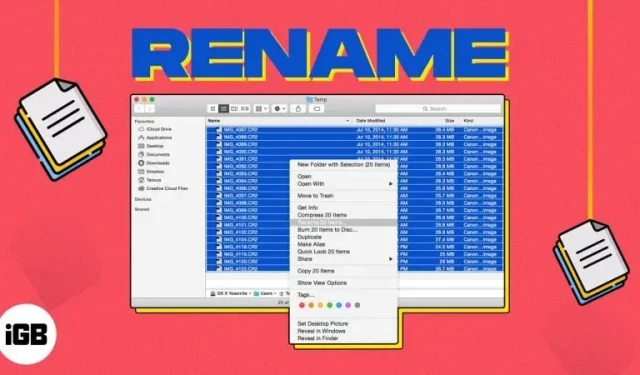On your Mac, giving your files recognizable names makes it easy to find what you need when you need it. If you have items such as screenshots that have default names when you save them, or files that you received from someone else, you can give them new names.
Thankfully, you don’t have to rename files one by one on macOS. In this article, I will show you how to batch rename multiple items on Mac using Finder.
How to Rename Multiple Files at Once on Mac
If you want to rename a single file, you can double-click the name to enter edit mode, give it a new name, and hit return.
But when you have multiple files that you want to rename, it can take a long time. Instead, you can use the Finder to change filenames.
- First, select the files you want to rename. Here’s how to select multiple files on Mac:
- Select all files in a folder: press Cmd (⌘) + A.
- Select multiple contiguous files: select the first file, hold the Shift key and select the last file in the group.
- Select multiple non-contiguous files. Select the first file by holding Cmd (⌘) and select each remaining file.
- Once you have selected the files, right-click and select Rename.
- You should see a drop down menu. Then use one of the options below to rename the files.
Format text
Using this option, you can format the filename with name and index, counter, or date with customizable options.
- Select Format from the top drop-down menu.
- Select the following options:
- Name Format: Use a name with a sequence number, count, or the current date and time.
- Where: Add an index, count, or date before or after the name.
- Custom Format: Enter the name you want to use.
- Start numbers in: For index and counter, you can start with any number you like.
- With each selection, you will see an example of what the file name will look like in the lower left corner. After selecting the options you want, click Rename.
Let’s look at an example:
- Here we will rename our files using the counter after the name “MyFile”, starting with the number 1.
- In this example, we will use the date in front of the “MyFile”name.
You should see the updated filenames.
Append text to current named files on Mac
Perhaps you don’t want to change the full name of the file, but rather add text to it.
- Select “Add Text”from the top drop-down menu.
- In the field on the right, enter the text that you want to add to the current name.
- From the drop-down menu on the right, choose to add text before or after the name.
- When you’re done, click Rename.
Here is an example. We add the text “IGB”in front of the name. Again, you can see a preview on the bottom left of how your filenames will be displayed.
You will then see the updated filenames.
Replace text in each file name in Finder
The last way to batch rename files on Mac is to replace text. This is handy if you want to keep part of the current name but use something else for the rest.
- Select “Replace Text”from the top drop-down menu.
- Enter the following parameters:
- Find: Enter the current text you want to replace.
- Replace with: Enter the new text you want to use.
- Click “Rename”when you’re done.
Here is an example of this option where we edit the default names for screenshots taken on a Mac. We will replace “Screenshot”with “Mac”.
And just like that, your files are renamed.
How to undo batch rename files on Mac
If you change your mind and want to revert back to the original filename, just do the following:
- Select the files you have renamed.
- Go to Edit in the menu bar → choose Undo Rename.
Alternatively, you can also use Cmd (⌘) + Z to undo the rename soon after.
Bulk rename files!
When it comes to batch renaming files on Mac, you have the option to use just about any name. So you can save time by changing the names manually and doing it in bulk.


